Animal That Looks Like an Anteater With Scales
WHat is a pangolin?
Pangolins are insect-eating mammals covered in tough, overlapping scales.
Come across the 8 Pangolin Species in Africa and Asia:
OvervIEW
Pangolins are uniquely covered in tough, overlapping scales. These mammals swallow ants and termites using an extraordinarily long, glutinous natural language, and are able to quickly curl themselves up into a tight brawl when they feel threatened. Eight dissimilar pangolin species can exist found across Asia and Africa. Poaching for illegal wild animals trade and habitat loss take made these incredible creatures 1 of the almost threatened groups of mammals in the world.
Taxonomy and Status
In that location are eight species of pangolins. All pangolins belong to the genus Manis in the family Manidae, which is the only family within the order Pholidota. Although pangolins share similar characteristics with Xenarthrans (anteaters, armadillos, and sloths), they are in fact more closely related to the order Carnivora (cats, dogs, bears, etc.).
Asian pangolins:
-
Chinese pangolin (Manis pentadactyla) – Critically Endangered
-
Sunda pangolin (Manis javanica) – Critically Endangered
-
Palawan pangolin (Manis culionensis) – Critically Endangered
-
Indian pangolin (Manis crassicaudata) – Endangered
African pangolins:
-
White-bellied pangolin (Phataginus tricuspis) – Endangered
-
Giant pangolin (Smutsia gigantea) – Endangered
-
Ground pangolin (Smutsia temminckii) – Vulnerable
-
Black-bellied pangolin (Phataginus tetradactyla) – Vulnerable
Physical CHARACTERISTICS
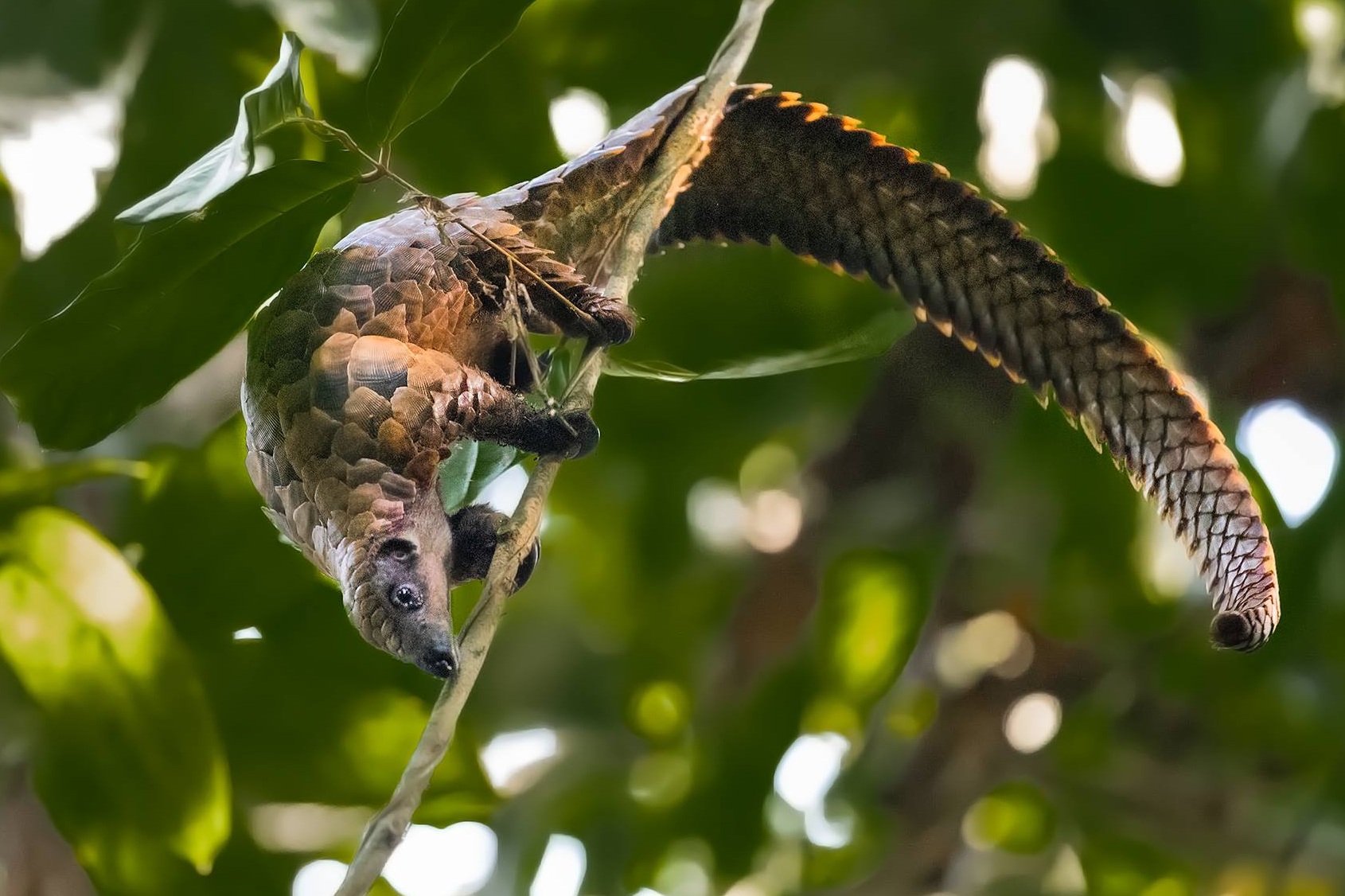
Black-bellied pangolins are expert climbers, using their claws and semi-prehensile tails to climb copse.
Pangolin species vary in size from virtually 1.6kg (~three.5 lbs) to a maximum of about 33kg (~73 lbs). They vary in colour from light to yellowish brown through olive to dark brown. Protective, overlapping scales embrace most of their bodies. These scales are fabricated from keratin — the aforementioned poly peptide that forms human hair and fingernails. Overlapping like artichoke leaves, the scales grow throughout the life of a pangolin simply similar pilus; scale edges are constantly filed downwards as pangolins dig burrows and tunnel through the soil in search of termites and ants. Pangolin undersides practice non accept scales, and are covered with sparse fur. The four Asian pangolins are distinguished from the African species past the presence of bristles which emerge from betwixt the scales.
With small conical heads and jaws lacking teeth, pangolins take amazingly long, muscular, and sticky tongues that are perfect for reaching and lapping up ants and termites in deep cavities. Pangolins accept poor vision, and so they locate termite and emmet nests with their stiff sense of olfactory property. A pangolin'due south tongue is attached near its pelvis and last pair of ribs, and when fully extended can be up to half the length of the animal's head and trunk. A pangolin'south tummy is muscular and has keratinous spines projecting into its interior. Usually containing small stones, the tum mashes and grinds prey in much the same mode equally a bird'southward gizzard.
Pangolin limbs are stout and well adjusted for digging. Each paw has five toes, and their forefeet have three long, curved, claws used to demolish the nests of termites and ants and to dig nesting and sleeping burrows. Pangolins shuffle on all four limbs, balancing on the outer edges of their forefeet and tucking their foreclaws underneath as they walk. They tin can run surprisingly fast, and will often rising on their hind limbs to sniff the air. Pangolins are as well capable swimmers, and while some pangolin species such equally the ground pangolin (Smutsia temmincki) are completely terrestrial, others, such as the black-bellied pangolin (Phataginus tetradactyla), are good climbers, using their claws and semi-prehensile tails to grip bark and scale trees.
DISTRIBUTION AND HABITAT
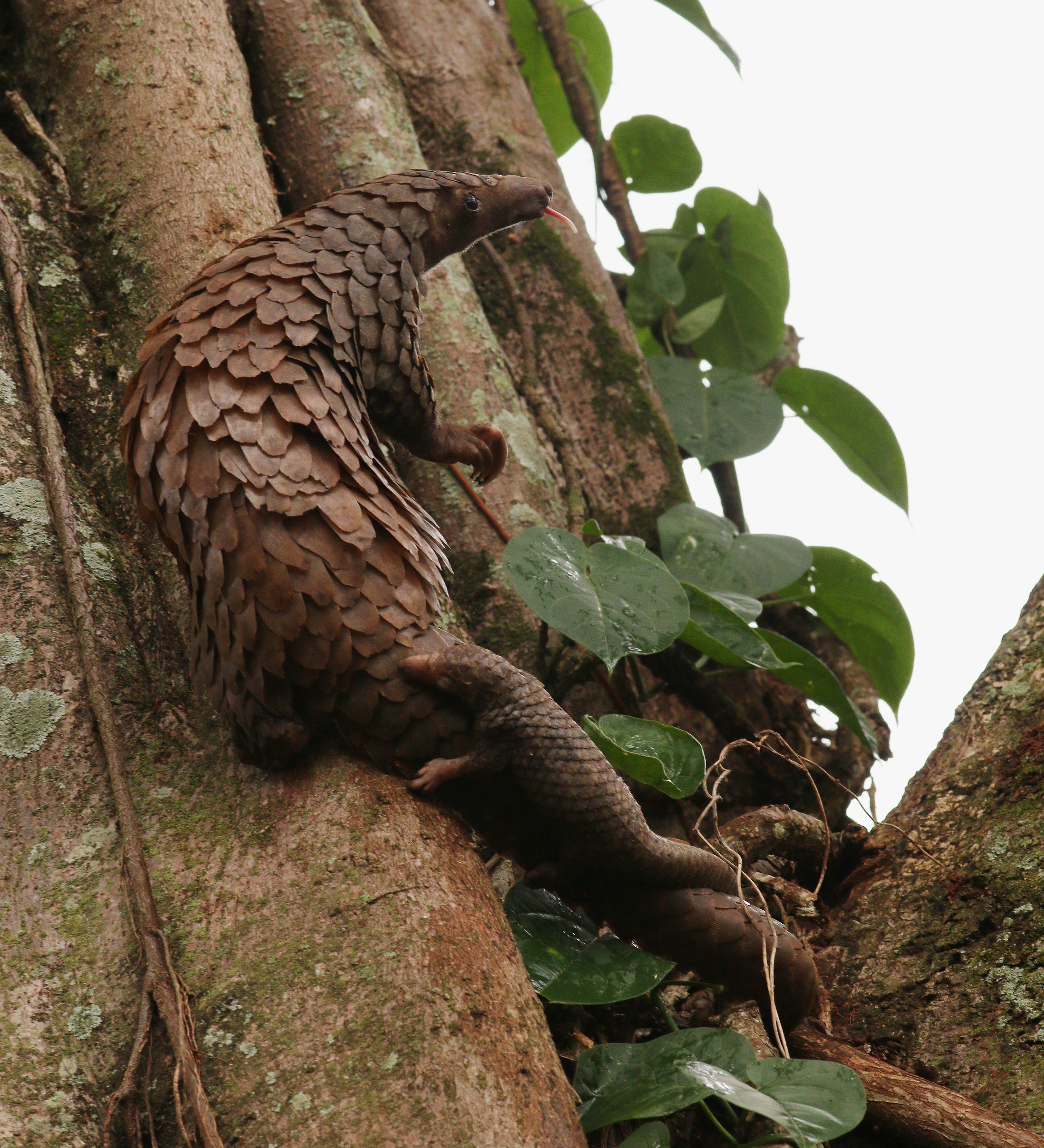
Pangolins live in a variety of habitats, from tropical forests to barren deserts.
Four pangolin species occur across Asia: the Indian pangolin, the Chinese pangolin, the Sunda pangolin, and the Palawan pangolin. Four species are constitute in Africa south of the Sahara Desert: the basis pangolin, the white-bellied pangolin, the giant pangolin, and the black-bellied pangolin.
Pangolins are found in a variety of habitats including tropical and flooded forests, thick brush, cleared and cultivated areas, and savannah grassland; in general they occur where large numbers of food (ants and termites) are found. Asian pangolins in item are threatened past loss of habitat due to expanding agronomics and other human uses. Pangolins dig deep burrows for sleeping and nesting that contain circular chambers. Large chambers have been discovered in terrestrial pangolin burrows that are big plenty for a homo to crawl inside and stand up. Some pangolin species such as the Sunda pangolin likewise slumber in the hollows and forks of copse and logs.
Diet
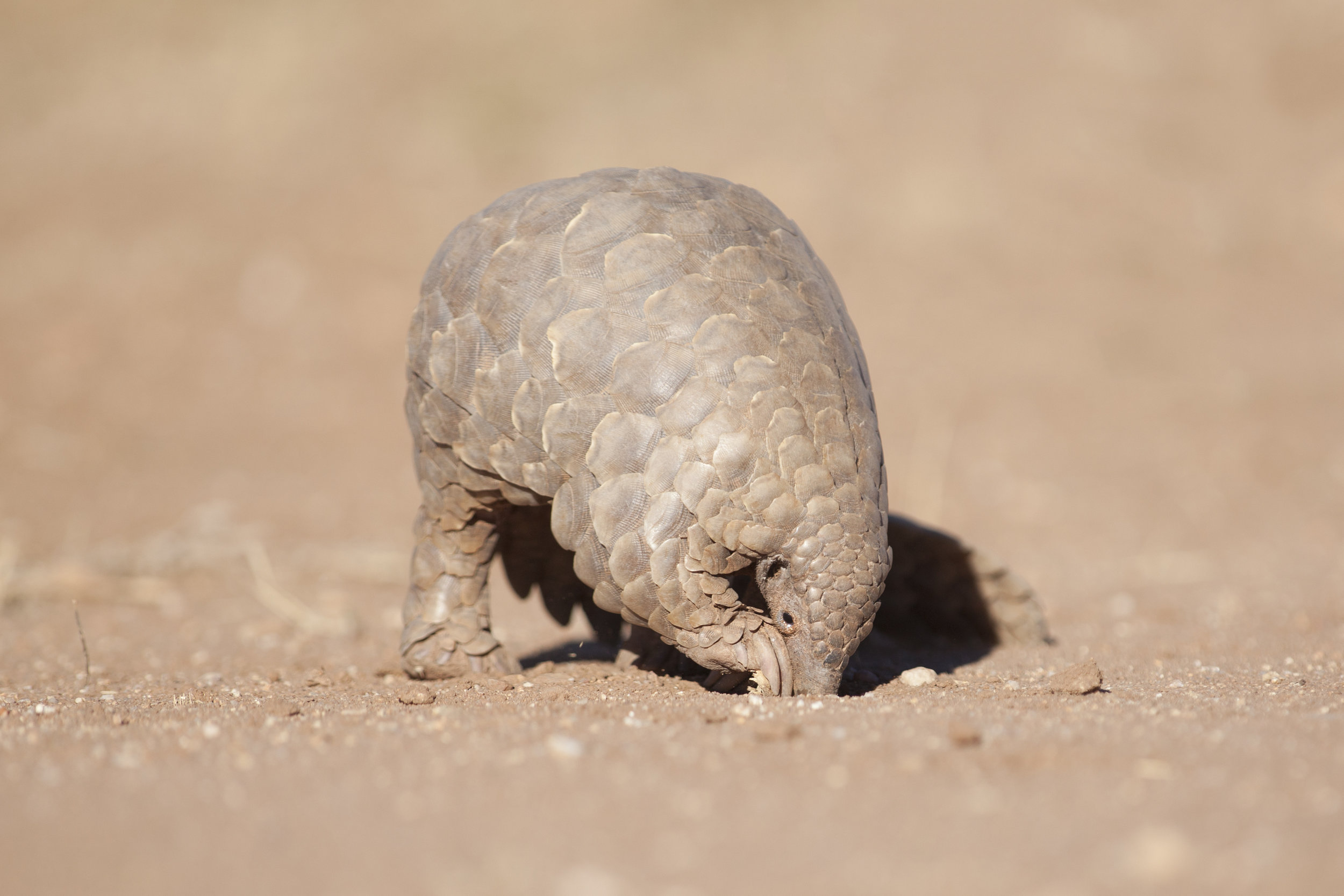
One adult pangolin can eat 70 one thousand thousand insects each year.
Pangolins live predominantly on a diet of ants and termites, which they may supplement with various other invertebrates including bee larvae, flies, worms, earthworms, and crickets. This specialist diet makes them extremely difficult to maintain in captivity—they oft reject unfamiliar insect species or get ill when fed foreign nutrient. Wild pangolins locate insect nests using a well developed sense of olfactory property. Voraciously excavation ants and termites from mounds, stumps, and fallen logs with their claws, they utilise their extremely long sticky tongues to capture and eat them.
Pangolins' clamorous ambition for insects gives them an important role in their ecosystem: pest command. Estimates indicate that one adult pangolin can consume more than lxx one thousand thousand insects annually. Pangolins have special muscles that seal their nostrils and ears shut, protecting them from attacking insects. They besides have special muscles in their mouths which prevent ants and termites from escaping later on capture.
BEHAVIOR
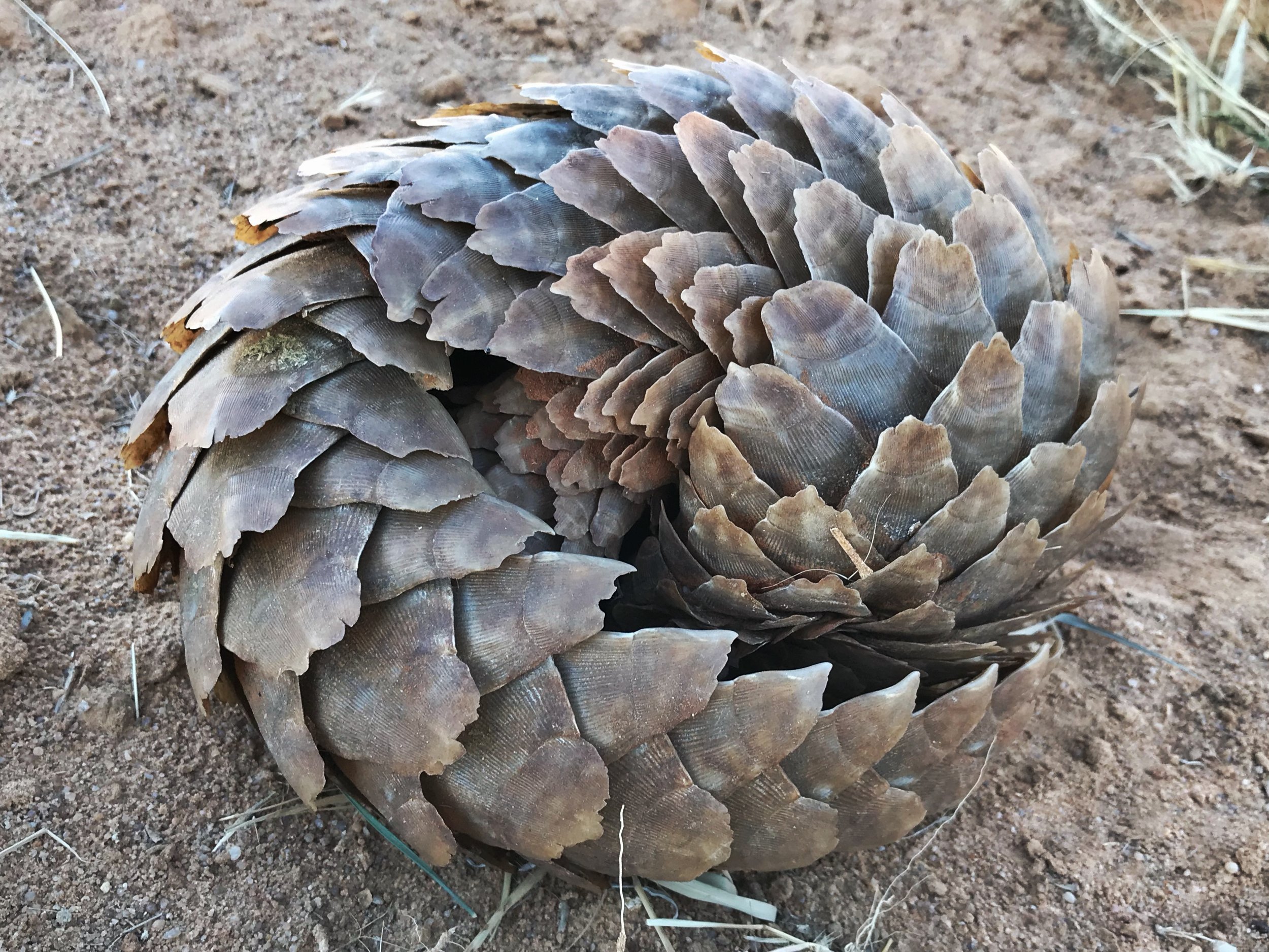
When threatened, pangolins ringlet upwards into a ball, using their scales like armor.
Pangolins are solitary, most are nocturnal and highly secretive; thus it is difficult for scientists to study them in the wild, and many mysteries remain near their behavior and habits. Some pangolin species such as the Chinese pangolin sleep in underground burrows during the twenty-four hours, and others including blackness-bellied pangolins and Sunda pangolins are known to sleep in trees. They emerge in the evening to provender for insects. Pangolins are well adapted for excavation: they dig burrows with their stiff front legs and claws, using their tails and rear legs for support and residuum. Tunneling underground, they excavate the sides and roofs of passages past pushing up and from side to side with their tough scaled bodies. They apply their front and hind feet to back accumulated soil toward the burrow archway, and vigorously kick clay out of the entrance upward to a meter or more.
Chinese pangolins in temperate areas spend the winter months in deep burrows. The winter burrows are strategically excavated near termite nests that provide a lasting food source. In Chinese legend pangolins are said to travel all around the world underground, and in the Cantonese language the name for pangolins translates to "the animal that digs through the mount," or "Chun-shua-cap," which translates to "scaly hill-borer."
While pangolins species share many characteristics and habits, there are as well differences. White-bellied pangolins are arboreal tree climbers, while ground pangolins are terrestrial ground dwellers. And some, including all four Asian species, are opportunistic and tin be found foraging both in trees and on the ground. Indian pangolins found in Sri Lanka reportedly alive in the rainforest canopy where fruit and flowers that attract ants occur, instead of at footing level where it is very dark and the food supply is limited. Some pangolin species even have semi-prehensile tails—they tin grasp and hang from branches with their tails, which aids them in climbing.
Pangolin scales provide good defense against predators. When threatened, pangolins can chop-chop curl into a brawl, protecting their defenseless undersides. They likewise deter predators by hissing and puffing, and lashing their sharp edged tails. Pangolins, dependent on their potent sense of smell, identify their territories by scent marking with urine and secretions from a special gland, and by scattering carrion. Scientists suspect that these odors advertise dominance and sexual condition, and may also help individuals recognize each other.
Reproduction and Lifespan
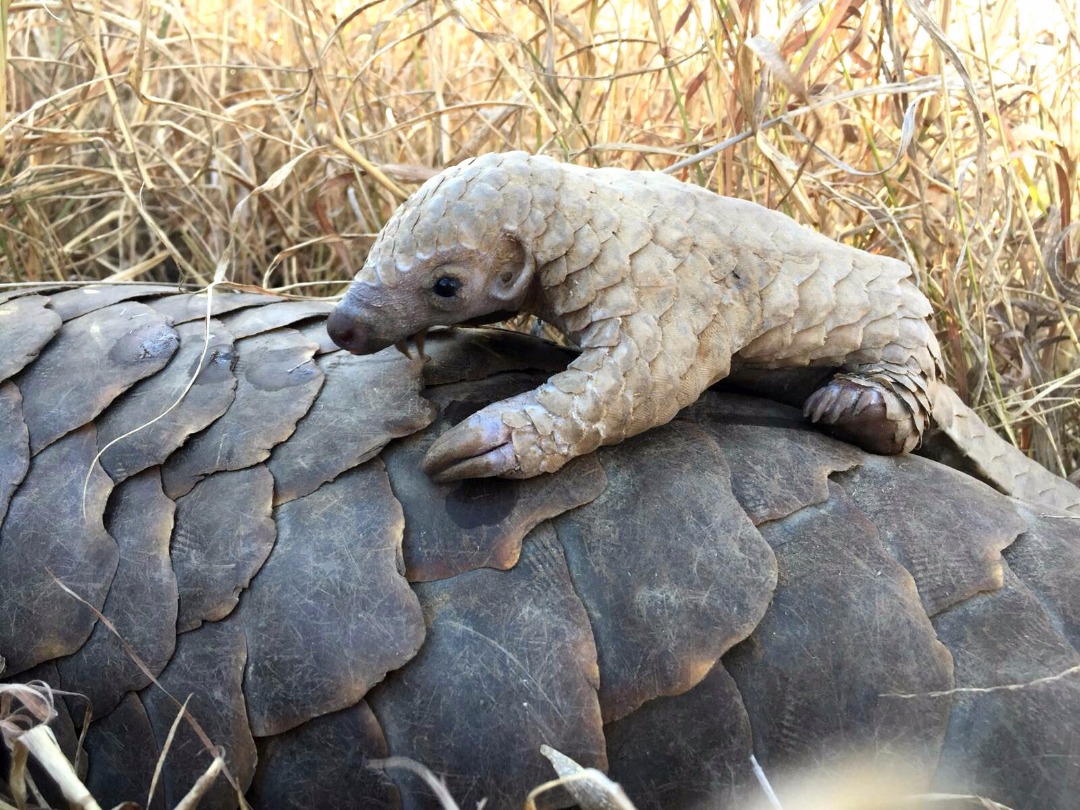
Infant pangolins ride on the backs of their mothers.
Male and female pangolins differ in weight; in most species, males are ten-l percent heavier than females. Pangolins reach sexual maturity at 2 years, and most pangolins requite birth to a unmarried offspring, though two and three young have been reported in the Asian species. When built-in, pangolins are about vi inches long and weigh well-nigh 12 ounces (0.75 lbs). Their scales are soft and stake, and brainstorm to harden by the second solar day. Pangolin mothers nurture their young in nesting burrows. A female parent volition protectively roll around her infant when sleeping or if threatened. Babies nurse for three to iv months, but can eat termites and ants at one month. Infant pangolins will ride on the base of the female parent's tail every bit she forages for insects.
Information technology is unknown how long pangolins tin can alive in the wild, though pangolins accept reportedly lived equally long equally 20 years in captivity.
Photo credits: Darren Pietersen; Scott Trageser; Sangha Pangolin Project; Tim Wacher; Stuart Nixon; Suzi Eszterhas/www.suzieszterhas.com; Katala Foundation; Gerald Cubitt; Anita Mishra; Elsa Bussiere
Animal That Looks Like an Anteater With Scales
Source: https://www.savepangolins.org/what-is-a-pangolin